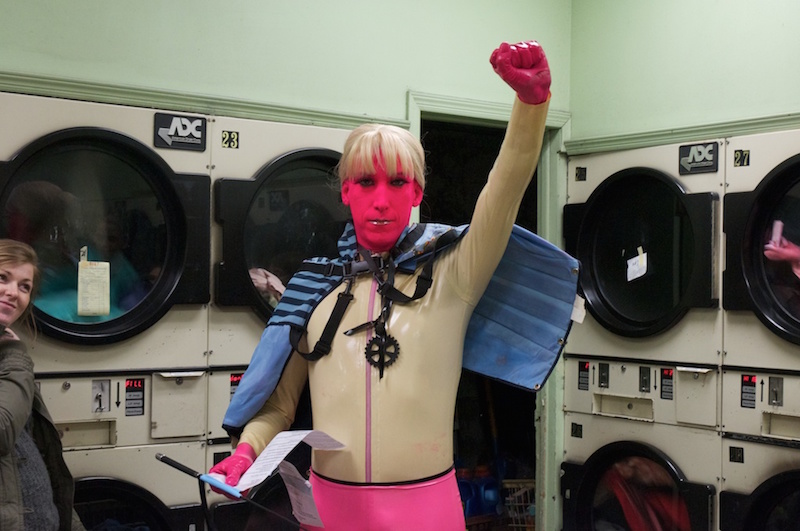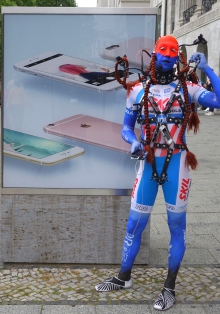The WorldWideWitches of Johannes Paul Raether
The WorldWideWitches of Johannes Paul Raether
Arielle Bier: Your practice is mainly defined by the identities you create. Can you describe each of them?
Johannes Paul Raether: At the moment, the most important identity for me and the work at transmediale is Protektorama, a witch within the lifeline of WorldWideWitches.
They are actually called Protektoramae in plural, as they have “forked,” which I call the process of making a new version of oneself. They are healing witches, but in their new form, Protekto.x.x., they are also rare metal researchers and so they function as “techno-alchemical” witches. They are smart phone fetish ritualists and spiritual materialists—which is a paradox at first, maybe. But the assemblage of materialistic and ritualistic practices and the search for occult materials of gadget culture is what drives them.
Then there is Transformella, Transformalor, or Transformellae in the plural, because they have has also forked themselves. They are “repro-revolutionaries.” They research the recent history of biotechnologies revolving around the production of children, and how repro-tech such as surrogacy or IVF is implemented on a global and industrial scale.
And then there’s Schwarmwesen, completing a triad of identities I am actively working with at the moment. It’s the youngest and most abstract, and can be rather hard to grasp. It’s more like an animal or a pet, a silent, language-less being, who appears in tourist traps across Europe such as Piazza della Signoria in Florence or Brandenburger Tor in Berlin. These are the three most important at the moment, while three others are in hibernation.

You also combine numerous elements of cyborg and scientific theory with esoteric thought and concepts of witchery. At what point did you decide to create a healing witch involved with technological devices?
I sometimes call my identities vessels—for ideas, thoughts, materials, or scraps I find. For example, the witch identity draws from my past, when I worked as a bird watcher. I lived on a remote island in northern Germany, watching birds all alone with someone who claimed to be a witch and introduced me to her world. She used all kinds of spells, stones, and other materials in her rituals and believed she was healing the Earth. But she didn’t want to heal mankind. She was an Earth healer and I was much more interested in world healing. We had a big fight about that. The entire experience left an imprint on me. This was before Silvia Federici published Caliban and the Witch, but her texts were a revelation for me: how she outlines the parallel becoming of capitalism and rationality in Europe during the witch-hunts, and how complex our society’s relationship to magic is, as it was purged from the body—particularly women’s bodies—during that time. Just recently, a friend gave me a text by Alfred Gell, who writes about the relationship between technology and magic from a very different angle. So, along the metaphor of the vessel, I combine a variety of different experiences and materials that are seemingly unrelated, and assemble them into a body, giving it flesh in the form of research, materials, and situations until it progressively comes alive.
Your identities regularly speak about posthumanist theory, futurology, and potentiality, almost carving out a science fiction context for a future that doesn’t yet exist.
If you look at my writing closely, I rarely talk explicitly about the future. I try to construct futurity rather through the potential for a completely different societal order in the present. To me, in every reality there is another reality that is slumbering, hidden, or unredeemed. With my work, I want to evoke this reality that is so completely reconstructed from what we are living in now that it seems alien or futurist, but is actually merely a total reconstruction of the fundamental paradigms of our “common reality,” which is a completely unbearable reality as long as sexism, racism, and capitalism exist.

What is the significance of interpreting our engagement with technology as ritualistic practice?
I call them healing rituals because I hope that these gatherings eject the audience—and also myself—from the normalized relationships we have with technology. Normality or common reality is a problem, as I just described. The automated relationships you develop after using a smart phone two or three times is type of ritual. Rituals create a heightened state of consciousness and very interesting moments of awareness, while social gatherings are the marketplace for breaking habits, or for finding ways to embody discomfort. We all have discomfort with technology, but we have few societal rituals in place for acting on it.
How does turning our fetish for technology into ritual function in your work?
Take, for example, the Apple flagship stores; what strikes me the most is the fetishizing of surface as a concept. This extremely polished and clean ideology is produced on the level of imagery and aesthetics, but it is almost graspable as a social behavior. A tangible illusion is created, suggesting that the devices function with a magic touch, an invisible hand on a glossy surface. How do you undo this notion without fetishizing the negativity of these ideal surfaces yourself, by, for example, throwing stones at them?
So, my strategy to work through this is to look at what’s behind the surface of smart phones—what’s in there, what they’re made of. What are the organs of this seemingly magic body? They are made from elements I never heard of before and their names sound fictional, like Dysprosium, Europium, and Yttrium. To me, they evoke occult materials, as these metals are potent, largely unknown, and invisible. They make our gadgets smaller and harder, stronger and faster. These materials break the surfaces. Bringing them back to the store is a conceptual rift in its magical gloss, because the material starts to speak about its own origin—its toxicity, its economy.
Do you think the internet has the capacity to heal? Or that technology has the capacity to heal?
No, absolutely not. I think that technologies have absolutely no potential whatsoever in and of themselves. In fact, I do think that most of the technologies that are at our disposal have very specific systemic determinations, which are the determinations of capitalist principles. To me, it would be ridiculous to insert the notion of hope into technology itself. We can only place hope in communities that bond and struggle, improve, fight or love. Technologies are tools and in opposition of capitalist principles. We need to extract them from their intended uses.

An important aspect of your identities is that they transcend normative definitions of gender. They’re fluid, changing, and as you say, “forking”—reproducing themselves with other features. What is your philosophy behind this?
I would like to connect both the constant changes and fluidness of the identities to the notions of technology I described. Identity has obvious technological aspects. Paraphrasing RuPaul, you could say, “We’re all born naked and the rest is tech,” and even this notion is crumbling in the face of an emerging repro-colonial move of our species to reproduce ourselves technologically. Makeup is a technology. My clothes are a technology within identity production. We repeat and reproduce this kind of technology every day. So, gender transformation by or as technology is also nothing to simply hope for. There’s no simple solution for that. On the street, normative binary gender and normative sexuality are very real and essential; as with technology, they serve a certain systemic function. I think to complicate the constellations of gendered bodies towards one another there is potential for liberation against a society that drives on efficiency and seamless exchange. To complicate gender is to extract it from its affirmative function. Everybody should be able to be their own gender, genus, order, or family.
In a way, it’s about dismantling stats quo divisions…
Yes. As much as ascriptions of certain character traits describe the colonial political economy, as in what is “black” and what is “white.” These divisions are societal constructions and it is tempting to render them as fictional. But unfortunately, they have gathered so much material, so many habits and conventions, rules and laws, that they seem to have become real over time. People who believe in them make them real and produce them as real. But they do not have to remain real. The potential of a society in which there is no such essential ascription towards male and female and towards black and white is always there within the established and common real. I think a lot of people work hard to excavate that potential and I want to be one of them. I want to contribute to the process by building bodies that seem to be fictional at first, but they also accumulate material, habits, and conventions over time, so that they produce another real against the real.
Like prosthetics, our smart phones and computers are colloquially described as extensions of our bodies. All of these elements appear throughout your projects. How do these prosthetics function for you?
From the moment Protektorama crystallized in 2011, she questioned whether prosthetics really work this way around. You are assuming that the phone is your prosthesis. Have you ever thought that maybe you are the prosthesis of the phone? That you are the prosthesis of what’s embodied in the phone, and what’s embodied in the phone exists because capitalist principles are embodied in it? This returns again to the concept of fetishism. It’s like a complete reversal of the human towards the object. You could easily say that we have become objects among other objects, which are circulated by a certain principle, and that principle is in itself not human. The relationship is based on a set of abstractions. It’s a set of digits and digits can be traded and there can be a derivative of each digit. Considering ourselves as human bodies in control of a prosthesis is totally constructed. This is where the witch injects and says, “You’re the fleshy prosthesis of the political economy that is embodied in your phone.” That might sound complicated, I admit, but that’s what’s at stake. Thinking through what is happening is constantly reengineering these preconditioned thoughts. For this, I need to be a witch, someone who reverts notions of the rational and the absurd, the ritual and the magical, of disembodiment or prosthesis, and everything related to healing the body.



